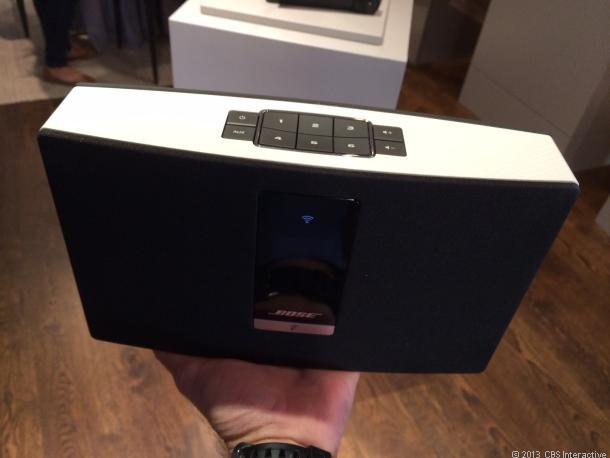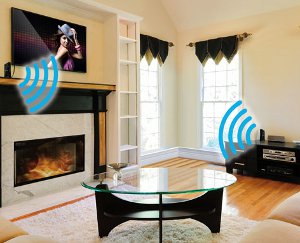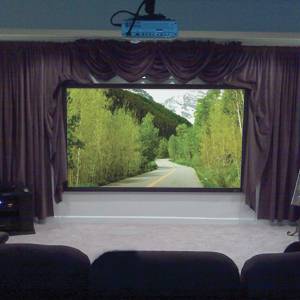
Bose SoundTouch throws down multiroom audio gauntlet to Sonos
New SoundTouch Wi-Fi line includes three speaker models at launch: the SoundTouch 30, SoundTouch 20, and SoundTouch Portable
 All the speakers have six 'presets' on top of the unit. This speaker is the SoundTouch Portable, which has a built-in rechargeable battery Over the years, Sonos, once a fledgling startup, has grown up to dominate the DIY multiroom wireless audio space. Now it has some serious competition.
Bose has officially unveiled a new line of Wi-Fi speakers under its new SoundTouch brand, which features simple setup and operation, and it’s definitely aimed at the same audience that Sonos has targeted.
The three new speakers that are available at launch — you can order them today — are the SoundTouch 30 ($699), a larger speaker designed for larger living spaces, and the SoundTouch 20 ($399) and SoundTouch Portable ($399), which are designed for somewhat smaller rooms. Bose will also introduce a Wave SoundTouch music system ($599) in December and other SoundTouch speakers and audio products in early 2014, signaling that it’s going all in on wireless audio.
It shares many of the same traits as the Sonos system, but one of the differences is that it’s designed to work with your existing Wi-Fi network and doesn’t require a special “bridge” like Sonos does. However, that Sonos Bridge, which connects to the Ethernet port on your router, sets up a separate “mesh” wireless network that’s dedicated to streaming your audio and helps remove the hiccups typically associated with a Wi-Fi network, which aren’t incredibly reliable.
But Bose is pushing the simplicity of its system and how easy it is to set up “using your existing home Wi-Fi network” and nothing else. The other simplicity theme revolves around Bose’s use of “presets”; both the new speakers and new apps — Android and iOS devices are supported at launch along with Macs and Windows PCs — are equipped with buttons numbered 1-6. Each number corresponds to a preset in the app.
Using the apps, you can drag and drop specific Pandora radio stations onto a number to set it as a preset. You can also link one of the presets to the music library on your PC or a specific playlist.
To get your music up and running, you simply press one of the preset buttons that’s on the speaker or the included remote, or within one of the apps. Thus, the SoundTouch name.
Sonos comparisons
Like Sonos, the speakers and apps will get software updates that add new features and services. At launch, I was underwhelmed with Bose’s line up of services. Beyond Pandora there’s nothing: no Spotifiy, no Rdio, no Deezer, no nothing. Sonos has a huge roster of service tie-ins, so Bose has a big hole to fill there.
The other thing you can’t do with the Bose SoundTouch speakers is combine two speakers to get stereo sound. That starts to get a little expensive when you’re combining $399 speakers to make a pair, but these types of speakers that have their drivers very close together typically feature little to no stereo separation, so it’s a nice option to be able to go stereo like you can with Sonos.
The SoundTouch 30 and SoundTouch 20 both offer Ethernet connectivity, so you can use a wired network connection if you want, and there’s an auxiliary input, so you can hook up an audio device to a speaker using a cable.
The Bose speakers aren’t equipped with Bluetooth (neither are the Sonos speakers), but they do support AirPlay streaming from iOS devices and PCs running iTunes. And like Sonos, you can stream music to a single room or have the same music play on all your speakers at the same time. You should be able to play different music sources in different rooms, but I didn’t test that feature yet.
Sound demo
Bose did a sound demo in a controlled environment with hand-picked music tracks, and like most of Bose’s demos, the speakers came across in their best light and seemed to sound quite decent for their size. I suspect the SoundTouch 20 will match up just fine against the Sonos Play:5, which is about the same size and also retails for $399. Currently, Bose isn’t offering any SoundTouch speakers for less than $399, but you’d think that may change in the future with Sonos offering more-affordable speakers.
However, the next batch of SoundTouch products will be more expensive except for the SoundTouch Controller, a swankier remote that will come out early in 2014 for $99.
As I said, a Wave SoundTouch music system is coming in December for $599. And a SoundTouch Stereo JC (Jewel Cube) system ($1,199), a SoundTouch SA-4 amplifier ($499) for select Bose products (including outdoor speakers), and a SoundTouch wireless adapter for Lifestyle systems and VideoWave entertainment system will ship in “early 2014.” (Bose did demo that new stereo Jewel Cube system, which also includes a subwoofer, and, needless to say, it sounded better than the single-speaker systems.)
I’ll let you know how the launch speaker systems sound — and how smoothly they operate — as soon as we get our hands on some review samples. Naturally, it will be interesting to see how the market responds to having a second major competitor in the DYI multiroom wireless audio space. But one thing is clear from Bose’s announcement: it’s going all in on wireless audio; it’s not messing around and will surely put big bucks toward marketing the new SoundTouch line and telling everybody how easy it is to use.
by David Carnoy
http://reviews.cnet.com/8301-33199_7-57606930-221/bose-soundtouch-throws-down-multiroom-audio-gauntlet-to-sonos/
Custom Installation Services, LLC – Authorized Bose Dealer in Charlotte, NC and surrounding areas
Posted in Audio Demos, Audio Systems, Home Theater, Home Theater Setup, Multi Room A/V, Music and Movies, News, Outdoor Speakers, technology
|
Tagged 3d theater in charlotte, bose dealer, Bose SoundTouch, Bose Theater, charlotte custom home builders, Charlotte Home Theater, geek squad in charlotte nc, high end audio, home automation companies in charlotte, home remodelers, Home theater installers Lake Norman, home theater setup, multiroom audio, Universal Remote programmers in charlotte nc, whole house audio, wireless audio, wireless networks
|
Wireless: Is It Really as Good as It Sounds?
Integrators need to educate customers better that ‘wireless’ audio does not mean ‘no new wires,’ and installing a cable-less system is not necessarily less labor intensive.
 Wireless has its place when used properly, but it doesn’t mean no new wires. It is obvious many custom manufacturers of multiroom audio systems are pinning their hopes for 2014 on new wireless audio products. Wireless is a wonderful solution; it eliminates the need to pre-wire a house and can be installed as a retrofit. Now that video can be transmitted around the home via wireless, audio transmission should be a breeze.
However, not wanting to be a wet rag, I would suggest caution. If anything sounds too good to be true, you can bet there is more to the story. When it comes to distributing audio around the home without cables, we should have a look at the practical implications more carefully.
Wireless is Not 100% Reliable
Wireless, of course is not new. My first foray into it was in the late 1960s with a wireless remote volume control. It was a fantastic idea—a little box was placed between the pre and power amplifiers so the level could be adjusted from your armchair. It worked well most of the time, but not all the time. On occasion it was slow to respond, which was quite irritating. But the real problem was when you pushed the “up” button, on occasions, it did not stop and then it would continue to increase the level unaided to full output, often destroying very expensive speakers.
Through the years wireless has greatly improved, but in a world hungry for convenience, for every improvement in wireless technology there has be a consequential demand to make it deliver more. For that reason it has never been perfect. Maybe 99 percent right at times but never 100 percent.
You may ask why is 99 percent not a good result? Those experienced in remote systems are well aware how unforgiving consumers are if they are not directly in front of a component. Now with IP-based solutions, we have upped the ante transmitting audio wirelessly as well as system control through the home. As good as we are getting with latency, the slightest drop out of signal can be very frustrating to most consumers.
‘Wireless’ Does Not Mean ‘No Wires’
As convenient as it is, a smart installer knows wireless can be fickle and when problems arise it can expose them to a lot of hassle and call backs, so hardwiring will always be their preference. To consumers, wireless solutions mean “no need to wire at all” to save costs and absolve them from need to employ an integrator or electrician or do any forward planning. The consumer needs to be better informed.
Wireless moves the amplifier from the central equipment cabinet into each individual room, which was one of the important parameters when we developed A-BUS. (Editor’s Note: A-BUS technology has the power supply located at the hub end where there is access to power. It is then sent down the Cat 5 cable to the amplifier located in the room with the speakers. Without the power supply, it is small enough to fit behind a single-gang wall plate or on the back of a speaker.)
Being from an audiophile background, long runs of speaker cable around the home have always been an anathema to me. If it is accepted, you should use good quality speaker cable to prevent signal losses to your speakers when they are just across the room from the amplifier. Running poor quality speaker cable (as our industry does) to the other end of a house must be wrong. So why do we do it?
Let’s look at why. Where do you put an amplifier in a bathroom? Even in a bedroom where you normally have a closet space available, generally homeowners don’t like electrical components hidden away in them. Putting them in ceilings sitting next to the speakers amongst the insulation material can be messy. Centrally located amplifiers in an equipment closet and nasty long speaker cable runs have been the norm.
If finding an amplifier location is hard, finding a convenient power point for it is even harder. The situation is no different to the plethora of wireless speakers coming on the market implying “no wires required.” Of course there are wires; each speaker has a thick power cord running out the back of it looking for a power point. In multiroom audio this can be very inconvenient as it introduces the need for a high-voltage installer (electrician) to be involved in the installation procedure adding complexity and expense to the installation. If the employment of an electrician is to be avoided you, have to contend most power points are located at floor level and most multiroom audio speakers are located in ceilings. In between there is a cabling job to be done, so wireless is not necessarily cableless!
Bluetooth Connectivity is in Demand
Wireless definitely has its place when used properly. Bluetooth in most instances simply replaces the need for a patch lead. It is designed to work within a room over a short distance, making it highly reliable. Now your phone has become your personal entertainment system, having a local Bluetooth wireless connection in each room is becoming a very important consumer feature.
So where is the wireless cost savings? First look at the additional cost of a power point per room and second at wiring additional IP points—a sensible installer wouldn’t risk a “wireless only” installation. Then look at the higher cost of amplification each with its own power supply and weigh these factors against cost of running cable.
I think we forget the origins of the custom market. It grew out of the consumer’s desire to eliminate messy wires and black boxes around the home. With our current rush to adopt new wireless technology, the industry and consumer appears to have lost sight of our most important goal; that is to provide “invisible home entertainment.”
By Andrew Goldfinch
http://www.cepro.com/article/wireless_is_it_really_as_good_as_it_sounds/K536
Custom Installation Services, LLC – First choice for low voltage wiring and home networking in Charlotte, NC and surrounding areas
Posted in Audio Systems, Automation, Blu-ray, Central Vac System, Flat Panel TV's, Home Theater, Home Theater Setup, IP Cameras, lighting control, Linksys, Low Voltage Contractors, Luxul, Media Rooms, Multi Room A/V, Netgear Routers, Network Setup, News, Outdoor Speakers, Structured Wiring, technology, Wireless Network
|
Tagged Booster, Bose, home network setup, home theater setup, lifestyle system, Linksys, luxul, Netgear, Structured Wiring, wilson cell booster, wireless router, wireless speakers
|
Sub-$6K Theater Delivers Satisfaction
 CIS - Charlotte's Source For Home Theater Installation/Design This budget-friendly home theater, and its 106-inch screen, provided the finishing touch to a finished basement.
One of the first things Phillip Thomas did after buying his 3,300-square-foot single-family home was finish the basement. He put in a bar, built a bedroom for his college-age son and threw in a nice-size bathroom. But he always felt that something was missing: a home theater.
“At the time, I thought that adding one would blow our budget out of the water,” Thomas says. So he and his family waited. After a few months of saving up, they contacted a local custom electronics professional for a quote. “They had a very firm budget of $10,000,” recalls Jason White of Commtech in Germantown, Md. “It was small, but it gave me some very clear parameters to work with.”
Since the basement was already finished and furnished, all of the money could go toward audio/video equipment and installation. That didn’t mean, however, that White could go crazy with the cash. “I had to be very careful about the products I selected,” he says. Obviously, the price of each component would need to fit the budget. But it was also important that the products chosen could be installed easily and would require minimal programming, White says. Oh, and the equipment would need to perform to the family’s expectations.
One of those expectations was a huge display. “I would settle for nothing less than 100 inches,” says Thomas. Consequently, the largest portion of the budget, $1,000, was allocated to a 106-inch projection screen from Draper. To avoid going over budget, fancy accessories like a motor that allows the screen to roll down from the ceiling were excluded.
A 720p Optoma projector finished off the projection system. Although it lacks the Full HD resolution of a 1080p model, it saved the Thomases more than $2,000. White made sure to run HDMI (high-definition multimedia interface) and extra Category 5 cabling to the projector location “just in case the Thomases ever decide to upgrade,” he says. The entire video setup came in at $2,000, which was about the same price as a much smaller 65-inch plasma or LCD TV.
White also stuck with the basics when it came to the audio/video receiver. The Denon AVR-590 is a quality piece, he says, but with one missing feature: HDMI upconverting. White explains, “A receiver with HDMI upconverting requires just one HDMI cable between the receiver and the projector. With it, any signal from any component will be upconverted to the 720p resolution of the projector.” The “HDMI switching feature” of the AVR-590, on the other hand, required White to route several additional cables from each component to the projector. The switching feature simply allows the signal from the connected source components to pass through to the projector without any enhancement in resolution. It was a minor sacrifice, White says, to save nearly $1,000.
Two fewer speakers would need to be purchased by going with a 5.1 surround-sound setup instead of a 7.1 system, and in-ceiling models would minimize the cost to have them installed.
“It’s usually easier to fish wiring through the ceiling to in-ceiling speakers than go through the ceiling and down the wall to install in-wall speakers because there are fewer obstacles,” says White. “It takes no more than five minutes to install an in-ceiling speaker compared to anywhere between 20 minutes to two hours for an in-wall model.” The 75-watts-per-channel rating of the five Proficient units may be less than the 100-watts per channel of the company’s higher-end units, but the Thomases saved $1,500 by sticking with the mid-grade models.
A final contributor to the savings was a stripped-down control device. The only two source components in the theater are a DirecTV satellite receiver and an upscaling DVD player, so the family didn’t need anything fancy, and so programming the URC MX-900 remote was basic.
Equipment
Draper 106-inch Onyx Matte White Screen ($999)
Optoma HD65 Home Theater Projector ($800)
Denon AVR-590 Home Theater Receiver ($350)
Panamax M4300 Power Manager ($249)
DirecTV HD Receiver (already owned it)
Samsung 1080P9 DVD Player ($90)
Proficient C660 LCR In-Ceiling Speakers ($580)
Proficient S10 Subwoofer ($249)
URC MX-900 Remote ($299)
Xantech IR Kit ($99)
Proconnect Cables ($420)
Consultation and Design Time ($1,500)
by Lisa Montgomery
http://www.electronichouse.com/article/sub-6k_theater_delivers_satisfaction/
Custom Installation Services, LLC – Audio/Video Sales, Service and Installation in North Carolina and South Carolina
Posted in 3D TV, Home Theater, Media Rooms, Music and Movies
|
Tagged 3-d, 3d, audio advice, basement theater, Best Buy, Charlotte, custom home builders in lake norman, HD installers in Charlotte nc, hd theater, high end audio, Home Theater, home theater furniture, home theater setup, home theater wiring, Media Rooms, Mooresville, Samsung, samsung ln46c650, tweeter charlotte, zobo
|
|
|
|






